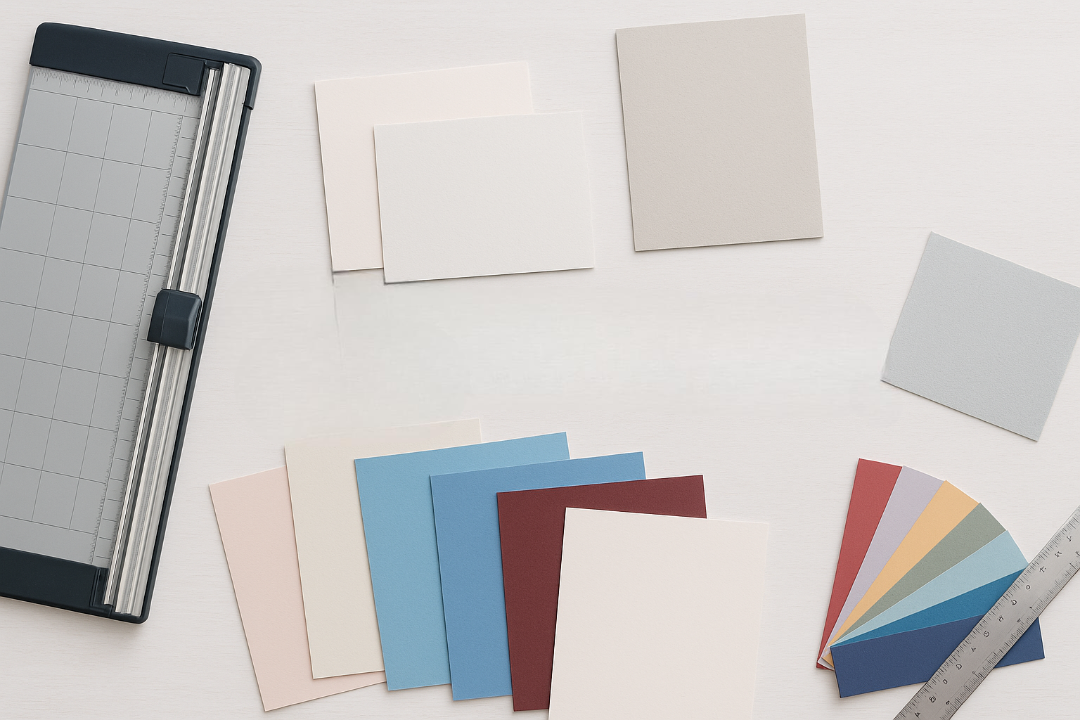What Is Card Stock? A Complete Guide to Its Types and Uses

Do you know why every DIY craft or a packaging box of designers and manufacturers is a highlight of their project. That’s because they are extremely selective with the paper they use. In the market, there are a variety of papers available with varied thicknesses. However, the challenge is to determine the correct one. For those who don’t know, quality is the best business plan. So, whether it’s a menu card of a restaurant, a retail tag of a dress, or a gift box for a jewelry item. The paper should provide a professional weight and a tactile experience. This is where the card stock comes in. It is durable than standard printer paper and more flexible than cardboard. However, card stock is a generic term. Under this come different types of papers based on weight, coatings, and texture.
In this blog, we will explore the entire landscape of card stock. We will focus on its types, finishes, and weight and find out their appropriate use.
Understanding the Card Stock
Card stock, often goes by the name cover stock, is a heavy-duty paper. It is durable and flexible. Also, it is bulky and thick as compared to a regular paperboard. But lightweight and thinner than paper or rigid board. There are two systems through which its weight is measured. One is the traditional US system that uses pounds, whereas the universally adopted system works on GSM units for more accuracy.
Pounds (lbs.)
In pounds, the weight of uncut 500 sheets (ream) of paper is taken into account as the actual weight of a sheet. For example, if a ream weighs 100 lbs, then the cardstock will be numbered as 85# and so does its weight. Nonetheless, this system is somewhat convoluted. That’s because the weight in one type of paper will result in a different actual paper thickness than the same weight in another paper type. The most common card stock paper available in pounds is: 65 (lbs.), 80 (lbs.), 100 (lbs.), 105 (lbs.), and 110 (lbs.).
GSM (Grams per square meter)
GSM is a simpler and universally adopted system. No matter what the size of your paper sheet is. GSM considers the actual weight of one square meter of the paper as an accurate weight. If the GSM number is higher. This means that the stock is heavier, thicker, and durable. Moreover, a heavy-duty brown card stock paper has a high cost and top-notch quality. The most commonly available card stock printing paper in the market is:
90 – 100 GSM
This paper is a perfect pick for crafting professional documents, flyers, and menus. It is lightweight but durable at the same time. You can fold it without cracking and conveniently print on double sides. The ink won’t bleed.
120 – 140 GSM
A 120 – 140 card stock has a more robust surface than a 100 GSM paper. That’s why it is safe to use this paper for pencil sketching, water coloring, letterheads, and movie posters. This paper is compatible with home and office printers and can work with vibrant, sharp details.
210 – 300 GSM
This is a premium quality paper that is not only sturdy. But it is resistant to wear and tear, too. It creates a professional-looking appearance, that is why this card stock paper is suitable for magazines and book covers, business cards, and certificates.
350 – 450 GSM
Do you know you can craft boxes with the help of card stock? Yes, a 350 to 400 GSM heavy paper is an ideal option for custom box packaging like cosmetics, jewelry, and gift boxes. You can die-cut this paper into any shape or size to make a box. It will not lose its structural stability. You can even emboss or foil-stamp this stock to create a tactile design. Apart from packaging, this paper is used to make greeting and informal invitation cards.
The Point System
Many people confuse GSM with thickness. GSM is a unit used to measure weight. Whereas thickness is measured in points, millimeters, and microns. However, the market point system is used for selling and purchasing card stock paper. According to this system, while measuring thickness, 1 point is equal to one-thousandth of an inch. In the market, you can find 10 pt. 12 pt. 14 pt. and 24 pt. sheets easily. 10 pt. is a standard paper while 24 pt. is a thick premium stock.
Different Cardstock Paper Types for Crafting and Printing
Unlike cardboard, the surface of a card stock paper is not smooth or plain. This paper comes in various finishes and textures, and that’s how it is categorized into different types. You can pick from the following types as per your need:
Coated vs. Uncoated finishes
Coated stocks have a smooth, refined surface. These papers are highly durable as they do not absorb the ink. This allows the colors to pop up and deliver every intricate detail with great vibrancy. Coated papers are great barriers. They are resistant to moisture and tearing and produce smudge-free art books and magazines. The best feature of these papers is that they come with various finishes, such as gloss, matte, and semi-gloss. However, there is a flaw too. Due to the inability to absorb ink, it is hard to write on them with a pencil or pen.
Uncoated card stocks have a textured surface with a fibrous structure. These papers have a rustic look and absorb ink. Compared to coated papers, they are less durable, and you can write on them with a pen or pencil. This stock is used to craft business cards, letterheads, and stationery essentials.
Popular finishes
Glossy stocks have a reflective surface that makes them durable and resistant to smudging and scratches. Despite this, a critical imperfection also exists. This reflective surface often causes glare. Thus, it becomes difficult to read text in a bright-lit environment. Visually, this paper has a polished look which elevates the color saturation and produces sharp images. Apart from gloss finish, you can find a matte finished card stock too. This paper has a non-slippery, sophisticated look. It has a velvety surface with excellent readability. It is highly recommended to use this stock to craft business cards and formal invites.
Specialty textures
Whether it’s a business card, wedding invite, gift tag, or customized corrugated boxes. Adding a texture to these card stocks can add depth and offer a tactile experience. Moreover, it makes the final product look luxurious. The most commonly applied textures on cardstock are:
- Linen
- Felt
- Satin
- Silk
- Cockle
- Foil stamping/Metallic Accent
- Embossed/Debossed
The Use of Cardstock in Crafting and Packaging Solutions
Since card stock is flexible, robust, and resistant to damage. Therefore, it is used in DIY projects and commercial settings. You can use this paper to craft:
- Business cards
- Postcards
- Invitations card
- book covers
- Greeting Cards
- Scrapbooking
- Certificates
- Menus
- Gift Tags
Wrapping it up!
There is no doubt that a card stock is an indispensable material for printing, crafting and designing business cards, wedding invites, gift tags, postcards, and custom boxes. So, if you want to design your own cards, get connected with Boxit Packages. We know how important money is. Therefore, we have the best deals and affordable rates for you with free shipping.



.jpg)